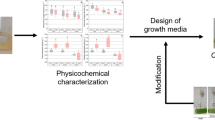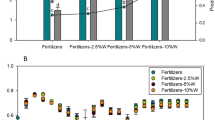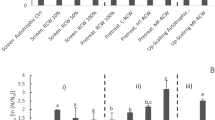Abstract
The cheese whey generation has become an environmental concern due to high levels of pollutants that can significantly impact on the ecosystem. Microalgae are known to eliminate nutrients/contaminants from wastewater, such as nitrogen, phosphorous, carbon and among others. The current work aims to evaluate dairy wastewater (such as cheese whey) treatment using Chlorella vulgaris. Several concentrations of coagulated and non-coagulated cheese whey and different inoculum sizes (0.1, 0.2, 0.4 and 1.0 g L−1) were used. Carbon (7–56%), nitrogen (0–71%) and phosphorous (11–46%) were removed. The final effluent containing coagulated cheese whey had lower levels of waste products compared to the non-coagulated cheese whey. Increments in the inoculum size lead to better results. In the assays with 0.2, 0.4, and 1.0 g L−1 of inoculum were removed 54, 56, and 41% of carbon, 71, 49, and 40% of nitrogen and 16, 31, and 46% of phosphorous, respectively.




Similar content being viewed by others
References
Abreu AP, Fernandes B, Vicente AA, Teixeira J, Dragone G (2012) Mixotrophic cultivation of Chlorella vulgaris using industrial dairy waste as organic carbon source. Biores Technol 118:61–66
APHA (2012) Standard methods for the examination of water and wastewater, 22 edn. American Public Health Association, American Water Works Association, Washington, DC
Audebert A, Fofana M (2000) Rice yield gap due to iron toxicity in West Africa. J Agron Crop Sci 195:66–76
Bertoldi FC, Sant’anna E, Oliveira JLB (2008) Chlorophyll content and mineral profile in the microalgae Chlorella vulgaris cultivated in hydroponic wastewater. Ciência Rural 38:54–58
Bohutskyi P, Chow S, Ketter B, Fung Shek C, Yacar D, Tang Y, Zivojnovich M, Betenbaugh MJ, Bouwer EJ (2016) Phytoremediation of agriculture runoff by filamentous algae poly-culture for biomethane production, and nutrient recovery for secondary cultivation of lipid generating microalgae. Bioresour Technol 222:294–308
da Borges WS, Araújo BSA, Moura LG, CoutinhoFilho U, de Resende MM, Cardoso VL (2016) Bio-oil production and removal of organic load by microalga Scenedesmus sp. using culture medium contaminated with different sugars, cheese whey and whey permeate. J Environ Manag 173:134–140
de Leite LS, Hoffmann MT, Daniel LA (2019) Microalgae cultivation for municipal and piggery wastewater treatment in Brazil. J Water Process Eng 31
Cai T, Park SY, Li Y (2013) Nutrient recovery from wastewater streams by microalgae: status and prospects. Renew Sustain Energy Rev 19:360–369
Carvalho F, Prazeres AR, Rivas J (2013) Cheese whey wastewater: characterization and treatment. Sci Total Environ 445–446:385–396
Chia MA, Lombardi AN, Melão MDG (2013) Growth and biochemical composition of Chlorella vulgaris in different growth media. An Acad Bras Ciênc 85:1427–1438
Daneshvar E, Zarrinmehr MJ, Hashtjin AM, Farhadian O, Bhatnagar A (2018) Versatile applications of freshwater and marine water microalgae in dairy wastewater treatment, lipid extraction and tetracycline biosorption. Biores Technol 268:523–530
Delgadillo-Mirquez L, Lopes F, Taidi B, Pareau D (2016) Nitrogen and phosphate removal from wastewater with a mixed microalgae and bacteria culture. Biotechnol Reports 11:18–26
Hooda PS, Yamdagni R (1991) Salt tolerance of guava (“Psidium guajava” L.) and aonla ('Emblica officinalis’) at germination stage. Res Develop Rep Haryana 8:36–38
Hu Q (2004) Environment effects on cell composition. In: Handbook of microalgal culture: biotechnology and applied phycology. Blackwell Publishing Ltd., Iowa
Jahan K, Mosto P, Mattson C, Frey E, Derchak L (2004) Metal uptake by algae. Waste Manag Environ II
Jeffrey SW, Humphrey GF (1975) New spectrophotometric equations for determining chlorophylls a, b, c1 and c2 in higher plants, algae and natural phytoplankton. Biochem Physiol Pflanz 167:191–194
Karimov A, Qadir M, Noble A, Vyshpolsky F, Anzelm K (2009) Development of magnesium-dominant soils under irrigated agriculture in Southern Kazakhstan. Pedosphere 19:331–343
Lee YK, Ding SY, Hoe CH, Low CS (1996) Mixotrophic growth of Chlorella sorokiniana in outdoor enclosed photobioreactor. J Appl Phycol 8:163–169
Lekshmi B, Joseph RS, Jose A, Abinandan S, Shanthakumar S (2015) Studies on reduction of inorganic pollutants from wastewater by Chlorella pyrenoidosa and Scenedesmus abundans. Alex Eng J 54:1291–1296
Li Z, Haifeng L, Zhang Y, Shanshan M, Baoming L, Zhidan L, Na D, Misheng L, Buchun S, Jianwen L (2017) Effects of strain, nutrients concentration and inoculum size on microalgae culture for bioenergy from post hydrothermal liquefaction wastewater. Int J Agric Biol Eng 10:194–204
Lowry OH, Rosebroughnj NJ, Farr AL, Randall RJ (1951) Protein measurement with the Folin Phenol reagent. J Biol Chem 193:265–276
Ma C, Wen H, Xing D, Pei X, Zhu J, Ren N, Liu B (2017) Molasses wastewater treatment and lipid production at low temperature conditions by a microalgal mutant Scenedesmus sp. Z-4. Biotechnol Biofuels 10:111
Martínez M, Leyton Y, Cisternas L, Riquelme C (2018) Metal removal from acid waters by an endemic microalga from the atacama desert for water recovery. Minerals 8:378
Montazer-Rahmati MM, Rabbani P, Abdolali A, Keshtkar AR (2011) Kinetics and equilibrium studies on biosorption of cadmium, lead, and nickel ions from aqueous solutions by intact and chemically modified brown algae. J Hazard Mater 185:401–407
Mujtaba G, Rizwan M, Kim G, Lee K (2018) Removal of nutrients and COD through co-culturing activated sludge and immobilized Chlorella vulgaris. Chem Eng J 343:155–162
Perezgarcia O, Escalante FME, Debashan LE, Bashan Y (2011) Heterotrophic cultures of microalgae: metabolism and potential products. Water Res 45:11–36
Prazeres AR, Carvalho F, Rivas J (2012) Cheese whey management: a review. J Environ Manage 110:48–68
Rangabhashiyam S, Balasubramanian P (2018) Characteristics, performances, equilibrium and kinetic modeling aspects of heavy metal removal using algae. Bioresourv Technol Rep 5:261–279
Razzak SA, Ali SAM, Hossain MM, DeLasa H (2017) Biological CO2 fixation with production of microalgae in wastewater—a review. Renew Sustain Energy Rev 76:379–390
Richmond A (2004) Handbook of Microalgal Culture: Biotechnology and Applied Phycology. Iowa State Press, a Blackwell Publishing Company, Ames
Rivas J, Prazeres AR, Carvalho F, Beltrán F (2010) Treatment of cheese whey wastewater: combined coagulation−flocculation and aerobic biodegradation. J Agric Food Chem 58(13):7871–7877
Ryu BG, Kim EJ, Kim HS, Kim J, Choi YE, Yang JW (2014) Simultaneous treatment of municipal wastewater and biodiesel production by cultivation of Chlorella vulgaris with indigenous wastewater bacteria. Biotechnol Bioprocess Eng 19:201–210
Seyfabadi J, Ramezanpour Z, Khoeyi ZA (2010) Protein, fatty acid, and pigment content of Chlorella vulgaris under different light regimes. J Appl Phycol 23:721–726
Sforza E, Simionato D, Giacometti GM, Bertucco A, Morosinotto T (2012) Adjusted light and dark cycles can optimize photosynthetic efficiency in algae growing in photobioreactors. PLoS ONE 7(6):e38975
Wang L, Addy M, Lu Q, Cobb K, Chen P, Chen X, Liu Y, Wang H, Ruan R (2019) Cultivation of Chlorella vulgaris in sludge extracts: Nutrient removal and algal utilization. Biores Technol 280:505–510
Wang L, Wang H, Chen X, Zhuang Y, Yu Z, Zhou T (2018) Acclimation process of cultivating Chlorella vulgaris in toxic excess sludge extract and its response mechanism. Sci Total Environ 628–629:858–869
Yan H, Han Z, Zhao H, Pan J, Zhao Y, Tucker ME, Zhou J, Yan X, Yang H, Fan D (2020) The bio-precipitation of calcium and magnesium ions by free and immobilized Lysinibacillus fusiformis DB1–3 in the wastewater. J Clean Prod 252:119826
Yang C, Hua Q, Shimizu K (2000) Energetics and carbono metabolismo during growth microalga cells under phototrophic, mixotrophic and ciclic light-autotrophic/dark-heterotrophic conditions. Biochem Eng J 6:87–102
Zheng H, Liu M, Lu Q, Wu X, Ma Y, Cheng Y, Addy M, Liu Y, Ruan R (2018) Balancing carbon/nitrogen ratio to improve nutrients removal and algal biomass production in piggery and brewery wastewaters. Biores Technol 249:479–486
Zhu S, Feng S, Xu Z, Qin L, Shang C, Feng P, Wang Z, Yuan Z (2019) Cultivation of Chlorella vulgaris on unsterilized dairy-derived liquid digestate for simultaneous biofuels feedstock production and pollutant removal. Bioresour Technol 285
Acknowledgements
The authors gratefully acknowledge the financial supports from Brazilian agencies: Foundation for Research Support of Minas Gerais (FAPEMIG, grants APQ-00101-15 and APQ-00785-18), Coordination for the Improvement of Higher Education Personnel (CAPES) and National Council for Scientific and Technological Development (CNPq).
Author information
Authors and Affiliations
Corresponding author
Ethics declarations
Conflict of interest
The authors declare that they have no conflict of interest.
Ethical approval
This article does not contain any studies with human participants or animals performed by any of the authors.
Additional information
Editorial responsibility: Sivakumar Durairaj.
Rights and permissions
About this article
Cite this article
de Almeida Pires, T., Cardoso, V.L. & Batista, F.R.X. Feasibility of Chlorella vulgaris to waste products removal from cheese whey. Int. J. Environ. Sci. Technol. 19, 4713–4722 (2022). https://doi.org/10.1007/s13762-021-03423-x
Received:
Revised:
Accepted:
Published:
Issue Date:
DOI: https://doi.org/10.1007/s13762-021-03423-x




